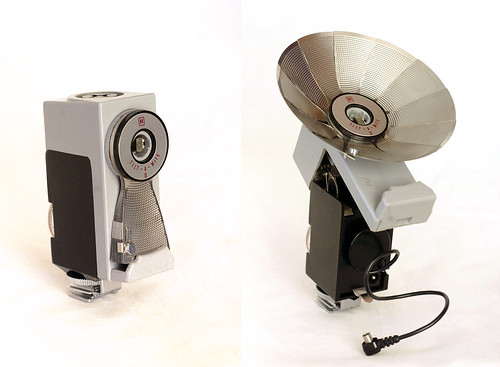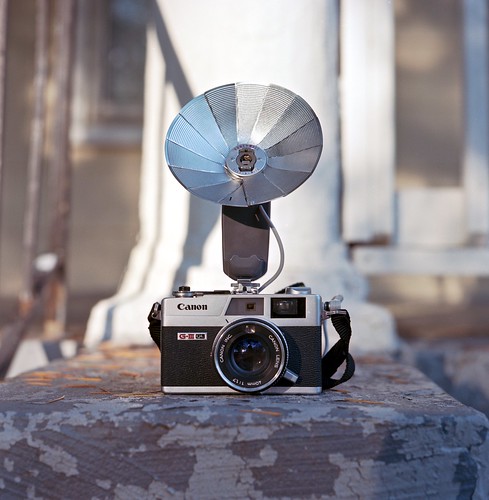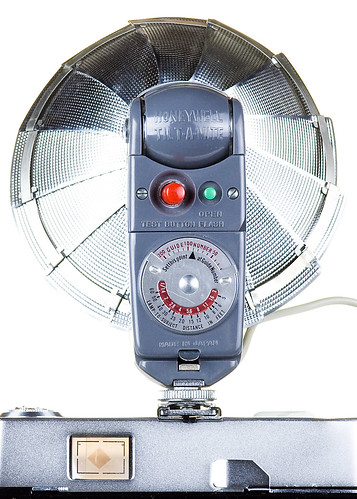Tilt-A-Mite

|
| Tilt-A-Mite II image by Voxphoto (Image rights) |
Tilt-A-Mite is a full-featured brand of flashgun sold by Honeywell beginning in the late 1950s[1], equipped with a foot for mounting into a camera's accessory shoe.
Flash guns and flash synchronizers had been the original products of Heiland Research Corp., of Denver, Colorado. Heiland had been pioneers of the B-C (Battery-Capacitor, or Battery-Condenser) flash unit, which had first appeared on the market in 1952, benefiting from the rapid advancements in capacitor miniaturization following the war. Heiland was acquired by Honeywell in 1954, primarily for access to their flash technology.
Tilt-A-Mites are B-C units for flashbulbs with a fan-fold reflector permitting compact storage. As the name suggests, the reflector can be angled away from the subject for bounce flash off the ceiling (or wall, depending on orientation). The "Mite" part of the name carried over from Heiland's mid-1950s Foto-Mite and Synchro-Mite flashguns. A small 15-volt battery (Eveready type #504) provides power to fire a variety of flashbulbs, most typically M3 or M3B.
The original Tilt-A-Mite has a round-topped case, a button to test continuity (without wasting a bulb), and its reflector can be narrowed to focus more light on distant subjects. The original unit can be found with either Heiland or Honeywell branding, though they are otherwise identical between the two brands. The sync cable offers interchangeable tips to adapt to different styles of sync connectors, which was important in the era before the PC style had emerged as the universal standard. Later versions of the original model Tilt-A-Mite include a clever sprung multi-ring bulb socket that can accept either midget base bulbs (such as the popular #5 or #25 bulbs), miniature base bulbs (such as the M-2 or M-3), or capless bulbs (such as the AG-1), without the use of adapters.
The Tilt-A-Mite II offers a more compact, squarer shape; it provides sync connection through its foot on cameras with a hot shoe, and it includes a top socket for flashcubes, which had become commonplace by the 1960s. For mounting without a hot shoe connection, a 12-inch sync cord can be unwound from its internal stowed position, and fitting only PC sockets.
Notes
- ↑ A price of USD $11.95 was quoted in Honeywell's June, 1959 Popular Photography advertisement (Vol. 44, No. 6; page 103)
Links
- Tilt-A-Mite user manual at Butkus.org
- Tilt-A-Mite II user manual at Butkus.org
- Original Tilt-A-Mite instruction sheet from ~Pixelsmithy on Flickr.
- Front and back views of original model, by dżejpi on Flickr

|
| Original Tilt-A-Mite, reflector tilted upwards image by Daniel Warshaw (Image rights) |

|
| Rear panel detail image by zoomclic (Image rights) |